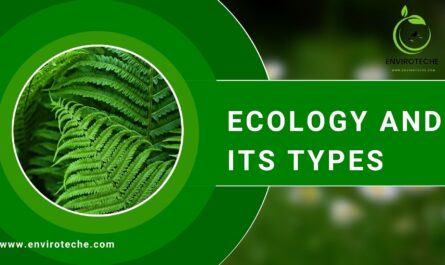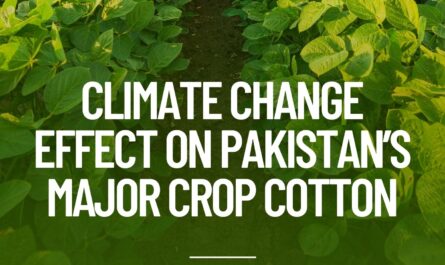
Maha Nazir1
1Department of Environmental Sciences, Government College University Faisalabad
Plastic is regarded as one of the most crucial products in our daily lives. However, massive piles of plastic debris pose serious environmental concerns. While much attention is focused on the impact of materials on marine ecosystems, their adverse effects on terrestrial environments are equally concerning. To avoid a catastrophic buildup of petroleum-based substances in the natural world, concerted worldwide action to minimize plastic usage is urgently needed.
Plastic pollution is widespread and can be differentiated by it. The largest amount of plastics is generated, consumed, and disposed on land. Since thermoplastics account for more than 80% of all plastics produced, processes that lead to the harmful release of plastics into terrestrial environments are better understood as the cause of plastic pollution worldwide (Hurley et al., 2020). Plastic that has been discarded on land is improperly handled and flows into the water. 80% of the plastic garbage is ocean island-based, while just 20% of it originates from ocean-based sources including fisheries and fishing vessels (Kosior et al., 2020).
This blog will address the effects of plastic trash on the environment and possible solutions.
Impact on Terrestrial ecosystem
- Wildlife entanglement and ingestion:
The accumulation of recyclable materials in the environment has a potentially dangerous effect on ecosystems and the human food chain. It also affects animals, birds, and marine animals. Plastic pollution affects their digestive tract, causing tissue destruction in the release of the toxic material known as PCBs, which can result in injury, suffocation, or starvation. They have developmental problems like as lower birth weight and long-term exposure may result in delayed egg hatching and reduced body weight, tail length, and body length (Ganguly et al., 2018).
- Soil contaminant:
Plastic decomposes extraordinarily slowly, and when it does, hazardous compounds are released into the soil, where they infiltrate the food chain and impair the quality of the soil. The composition and structure of soil are directly impacted by the contamination of the terrestrial segment brought on by plastics made from petroleum as well as bioplastics.
Through the creation of channels for water movement, the presence of plastic in soil has affected the saturation of water and raised the frequency of water evaporation. Numerous factors, including vulnerability to microbial degradation, which adds to soil nutrient depletion, influence the fate and behavior of plastic particles. A variety of end metrics, such as mortality, development, reproduction, enzyme activity, and additional metabolic processes, were utilized to gauge the impact of bioplastics on the soil. (Silva et al., 2021).
- Human health concerns:
Due to their low cost and wide range of practical qualities, plastics are seen as an essential component of today’s economic environment, despite the fact that they represent substantial health risks to both humans and the environment. According to recent studies, concerns about the detection of some chemicals in humans, such as phthalates and bisphenol A, in the materials to which most people are exposed, are growing. These chemicals cause cancer and have the potential to change the endocrine system (Kumar et al., 2018).
- Contamination due to microplastic
Most microscopic plastic is derived from terrain, and is classified as macro-(>5mm), micro-(1-5mm), or nano plastic (1m). Micro Plastic accumulation can occur in the terrestrial setting through primary sources such as the immediate addition of microplastics manufactured at micro meter-sized fragments in multiple industries, or secondary sources such as physical, chemical, and biological products fragmentation of macro plastic. Recent scientific interest in microplastics during the last decade has proven that they exist in aquatic as well as terrestrial settings and are having a significant impact on ecosystems (Oleszczuk et al., 2022).
Potential solutions to beat plastic pollution
Analyzing the environmental effects of plastic waste reveals that immediate and concerted action combining pre- and post-consumption solutions might halt the trend of rising plastic pollution. Although current technology and knowledge can solve 78% of the issue of plastic pollution by 2040, major dedications towards enhancing the world’s plastic structure will be needed from the private sector, the public sector, and other nations in order to solve the ecological, social, and economic problems associated with plastic contamination while achieving near-zero feedback of materials into the environment (Bailey et al., 2020).
Here is some method for the management of plastic waste:
Plastic-coated bitumen road:
This approach is used to build flexible roads out of waste plastic. Here is a quick overview of the building process of polymeric (plastic) coated bitumen road.
- Gathering, classifying, and storing plastic waste
- The drying process of the plastic waste and shredding them to the desired size
- Stone aggregate, such as granite ceramic, is heated to between 160 and 170 degrees Celsius.
- Shredded polymer waste (5-10% by weight) is then added to the heated stone aggregate and mixed for 30 to 40 seconds to provide a uniform coating on the surface of the aggregate.
- Waste plastic aggregate and bitumen mix is a mixed composite that is used for laying roads at temperatures between 110°C and 130°C (Siddiqui et al., 2013).
Plastic waste co-processing in cement kiln
There are initiatives that attempt to turn garbage into novel sources of energy in addition to recycling plastic for use in new products and energy conservation. Municipal solid garbage contains plastic that is produced in many cities. The central board of pollution control (CPCB) and the M. P. pollution control the Surface took the initiative to use plastic waste in cement plants to address the issue of disposing of plastic waste, and stack tracking showed that emission levels were found to be beneath the standard set for common hazardous waste incinerators. No sorting or cleaning is required for this method of disposal, which helps conserve the planet’s finite supply of petroleum (Siddiqui et al., 2013).
Pyrolysis of plasma
Plasma Waste segregation is not necessary, and extremely high temperatures ensure that every kind of waste is treated without discrimination. Pyrolysis is a method that combines the thermo-chemical properties of the plasma with the pyrolysis process. It can eliminate all types of plastic waste due to the extreme temperature and flexible heat-generating ability of combustion technology (Siddiqui et al., 2013).
Liquid fuel from plastic waste
This method is straightforward and suitable for all plastic waste, including unclean, unsorted, and recyclable but tough plastic. The system is capable of handling both small and large goods, including automotive bumpers, fuel tanks, packaging for petroleum products, agricultural film, and packaging for medicines. An automated system oversees the entire process, which uses natural gas to initiate the operation and supply heat (Siddiqui et al., 2013).
Reference
de Souza Machado, A. A., Kloas, W., Zarfl, C., Hempel, S., & Rillig, M. C. (2018). Micro plastics as an emerging threat to terrestrial ecosystems. Global change biology, 24(4), 1405-1416.
Dissanayake, P. D., Kim, S., Sarkar, B., Oleszczuk, P., Sang, M. K., Haque, M. N., … & Ok, Y. S. (2022). Effects of micro plastics on the terrestrial environment: A critical review. Environmental Research, 209, 112734.
Islam, M. R., Ruponti, S. A., Rakib, M. A., Nguyen, H. Q., & Mourshed, M. (2023). Current scenario and challenges of plastic pollution in Bangladesh: a focus on farmlands and terrestrial ecosystems. Frontiers of Environmental Science & Engineering, 17(6), 66.
Kumar, P. (2018). Role of plastics on human health. The Indian Journal of Pediatrics, 85(5), 384-389.
Malizia, A., & Monmany-Garzia, A. C. (2019). Terrestrial ecologists should stop ignoring plastic pollution in the Anthropocene time. Science of the Total Environment, 668, 1025-1029. Plastics
Siddiqui, J., & Pandey, G. (2013). A review of plastic waste management strategies. Int. Res. J. Environ. Sci, 2(12), 84. Ullah, R., Tsui, M. T. K., Chow, A., Chen, H., Williams, C., & Ligaba-Osena, A. (2023). Micro (Nano) plastic pollution in terrestrial ecosystem: emphasis on impacts of polystyrene on soil biota, plants, animals, and humans. Environmental
Check Other Schlorships:

